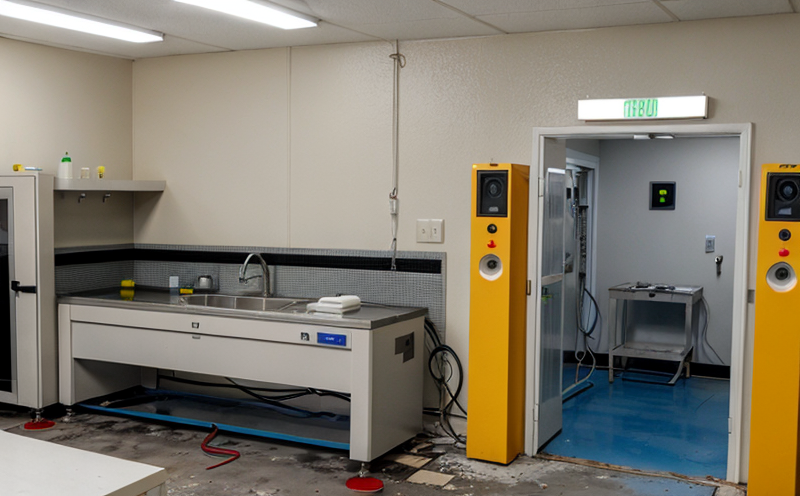ISO 8690 Performance Testing of Surface Contamination Monitors
The ISO 8690 standard provides a comprehensive framework for the performance testing of surface contamination monitors. This service ensures that radiation detection devices comply with international standards, providing reliable and accurate measurements essential in various sectors such as nuclear power plants, medical facilities, and research institutions.
Surface contamination monitoring is crucial to prevent the spread of radioactive materials within environments where human activity occurs. These monitors are used to detect alpha, beta, gamma, and neutron emissions from contaminated surfaces. The ISO 8690 protocol outlines a series of tests designed to evaluate the performance characteristics of these devices, including their sensitivity, stability, reproducibility, and response time.
The testing process involves exposing the monitor to a range of radioactive isotopes known for their distinct emission properties. Each test is conducted under controlled environmental conditions to ensure accurate results. The specimen preparation typically includes creating calibrated contamination sources that mimic real-world scenarios. These sources are then used in conjunction with the monitor to assess its performance.
The apparatus used during these tests includes a variety of radioactive isotopes, such as 90Sr for beta particles and 137Cs for gamma radiation. The test setup is designed to simulate the conditions under which the monitors would be used in practice, ensuring that any discrepancies are identified early on.
The acceptance criteria for a successful ISO 8690 test include:
- Sensitivity: The monitor must detect contamination at or below specified thresholds.
- Stability: The monitor's response should not vary significantly over time.
- Reproducibility: Consistent results across multiple tests are essential for reliability.
- Response Time: The device must respond quickly to changes in radiation levels.
The testing process is rigorous and detailed, ensuring that the monitors meet international standards. This service is particularly important for facilities handling radioactive materials, as it helps maintain compliance with regulatory requirements and enhances safety practices.
In real-world applications, this service ensures that contamination monitoring devices are functioning accurately, which is critical in environments where even minor discrepancies could lead to significant risks. By adhering to ISO 8690 standards, we provide peace of mind for our clients, knowing their equipment meets the highest industry benchmarks.
Benefits
The benefits of ISO 8690 performance testing extend beyond mere compliance; it enhances overall safety and efficiency in radiation management. For quality managers and compliance officers, this service provides a robust framework to ensure that all monitoring devices are functioning as expected.
- Enhanced Safety: Accurate detection of surface contamination reduces the risk of accidental exposure.
- Improved Efficiency: Reliable monitors save time and resources by minimizing false alarms and ensuring immediate action where needed.
- Regulatory Compliance: Ensuring adherence to international standards helps avoid costly penalties and legal issues.
- Precision Measurement: The tests provide precise data that can be used for continuous improvement of radiation safety measures.
For R&D engineers, this service offers a benchmark against which new technologies and methodologies can be evaluated. It also facilitates the development of more accurate and efficient monitoring systems.
In summary, ISO 8690 performance testing is an indispensable tool for maintaining high standards in radiation safety across various sectors. By leveraging this service, our clients can ensure that their equipment is not only compliant but also at the forefront of technology.
Quality and Reliability Assurance
The quality assurance process associated with ISO 8690 performance testing involves meticulous preparation and execution of each test. The laboratory adheres strictly to international standards, ensuring that all procedures are conducted under controlled conditions. This approach guarantees the reliability and accuracy of the results.
Before commencing any tests, the laboratory conducts a detailed review of the equipment being tested. This includes verifying calibration certificates and conducting preliminary checks to ensure the devices are in optimal condition. The use of calibrated radioactive sources allows for consistent and repeatable test results.
The testing process itself is methodical and involves multiple phases:
- Setup: Calibration of the monitor with known contamination levels.
- Exposure: Exposure to a range of radioactive isotopes under controlled conditions.
- Data Collection: Recording the monitor's response during and after exposure.
- Analysis: Comparison of collected data against predefined acceptance criteria.
The laboratory employs advanced instrumentation for these tests, including calibrated contamination sources and sophisticated monitoring equipment. This ensures that even minute changes in performance can be detected and reported accurately.
The results are meticulously documented and analyzed to identify any deviations from expected behavior. Any issues identified during the testing process are addressed promptly, ensuring that only compliant devices pass the test. This commitment to quality and reliability is a cornerstone of our service offering.





